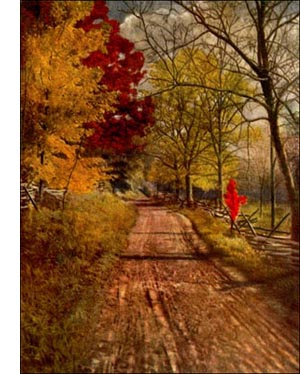Prickly Ash or Toothache Tree
 The Prickly Ash, or Toothache Tree (Fagara ClavaHerculis, Small) has all the characteristics suggested by its names. Its compound leaves resemble those of the ash except that these alternate on the twig, while ash leaves are always opposite. The twigs are set with sharp prickles, each raised on a corky base. In Arkansas, where the tree forms thickets of considerable extent, it is also called "tear-blanket" and "wait-a-bit"!
The Prickly Ash, or Toothache Tree (Fagara ClavaHerculis, Small) has all the characteristics suggested by its names. Its compound leaves resemble those of the ash except that these alternate on the twig, while ash leaves are always opposite. The twigs are set with sharp prickles, each raised on a corky base. In Arkansas, where the tree forms thickets of considerable extent, it is also called "tear-blanket" and "wait-a-bit"!There is an acrid, resinous juice in the twigs, leaves and bark which is used as a stimulant in medicine. The bark of the roots is especially bitter. The Negro in the South chews a piece of prickly ash bark to cure the toothache. "Sting-tongue" and "pepperwood" he calls it, for it produces a burning sensation and a copious flow of saliva. Possibly it is as a counter-irritant only that it relieves the pain. Belief in its curative powers is widespread; the collecting of its bark has almost exterminated the species along the southeastern coast.
The prickly ash in its best estate looks like a well-grown apple tree, and often grows over 40 feet in height. It is found along streams in sandy soil from Virginia to Florida and west to Texas and Arkansas. As a rule it is under 25 feet in height. The small, greenish flowers are clustered on. the ends of branches. The birds are fond of the aromatic seeds which hang out of the seed cases in the autumn.
The prickly ash of the North is Fagara Americanum, a shrub found on mountain slopes from Quebec west to Nebraska and Missouri, and south to Virginia. It will easily be recognised by its abundant prickles and bitter taste. Its leaves have fewer leaflets than the Southern species, and the flowers are borne in small, sessile clusters in the axils of last year's leaves.
Fagara flava, Kr. and Urb., is the "satinwood" so much sought for in the West Indies. It once grew on all the Florida Keys, but is now extinct on all but three of them. Its wood has a beautiful satiny lustre when polished, and when fresh sawed has the odour of the true satinwood of the East Indies.
Fagara Fagara, Small, is a shrubby tree of this genus which is found growing in southern Florida and along the Texas coast. It is known as the wild lime.